




![]()

The lineage of the M-60 Patton tank began with the introduction of the Pershing M26-E3 prototype at the end of WWII. The M-26 Pershing was a test bed for a new design incorporating sloped armor and torsion bar suspension. These formed the basis for the M-46, which used the same basic hull with improvements.
The M26 Pershing entered service in 1945, though the tank saw limited service during WWII, and saw service in Korea in the 1950's. It was the ancestor of the Patton and a long line of post-war tanks up to the M-60. Predecessor of the M48, the M47 is a descendent of the M26 Pershing Tank. With a 90 mm gun, the M26 could meet the Tiger and Panther on equal terms. With the long barreled gun, heavy armor and Ford V-8 engine, this was the best American tank of WWII. The most significant deficiency noted was the poor power-to-weight ratio due to the Ford engine. Although adequate for the 35 ton Sherman, it caused the M-26 to be grossly underpowered.
In 1942 the Army Ordnance Department received orders to start development of the T20 medium tank. The tank was to incorporate improvements over the M4 Sherman, and also to serve as a testbed for various combinations of armament, transmissions and suspensions. It was decided to construct three prototypes equiped with interchanging turrets and the maximum total weight of thirty tons. These tanks were called respectively the T20, T20E1 and T20E2. All were equipped with the Ford GAN V-8 motor and "Hydramatic" automatic transmission without brace converter. The tanks were to allow experiments, but they were never intended to enter in service because in the meantime more modern vehicles were designed.
Great technical strides were made not only in more powerful guns, better armor, and more powerful engines, but also in the transmission and suspension mechanisms. Furthermore, the search was continuous for more effective ammunition and less weight in all components.
In parallel with the T20 series there was elaborated a new called model T22 (similar to the T20 but with the same mechanical transmission of the M4) and the T23 (identical to the T22 but with suspensions of the type mounted on the M4 and a motor from General Electric). In September 1942 the Ordnance Department suggested to arm one of T23 prototypes with a 90 milimeter gun. In 1943 there was a request for the production of fifty new vehicles, forty of which would be equipped with the same level of protection of T23 and ten of heavier armor in a position to compete with the German Tiger and Panther. Two heavy tank designs followed, the T25 and T26. Both mounted the a 90mm gun, but the T26 was given the higher priority. The turret was cast, but the hull was made from a combination of castings and rolled plate.
Continued experiments toward the development of a more reliable heavy tank were largely inspired by the appearance in 1943 of German heavy Panther (47-ton) and Tiger (63-ton) tanks. American tank crews discovered in combat that the Sherman was badly outclassed by German medium and heavy tanks, most notably the Mark V Panther and the Mark VI Tiger. With their heavier armor, the Panther and Tiger were almost impervious to rounds fired from the Sherman’s 75 or 76 mm main gun; conversely, the 88 mm gun on the German tanks usually made short work of their American opponents.
On 24 May 1943 The War Department approved production of 10 T26 tanks as part of a larger production order on T20-series tanks. In an indorsement to an earlier Armored Command letter requesting adjustment to the production numbers of M4, on 13 September 1943 , the Ordnance Department requested production of an additional 500 T26s. General Lesley J. McNair, CG of AGF, successfully opposed this request. On 13 November 1943 General Jacob Devers, CG of the European Theater of Operations, requested production of 250 T26s.
Because of McNair’s continued opposition to production of the T26 and other objections, on 7 December 1943 MG Joseph McNarney queried Devers whether his request was based on operational requirements. On 10 December 1943, Devers confirmed his request for production of 250 T26s. As of 21 February 1944 the Ordnance Department estimated first production of the 250 T26s in October 1944. Production actually began in November. Prototypes from the batch of 10 ordered in May 1943 started arriving during February 1944. On 20 May 1944 The
Armored Board at Fort Knox emphasized that the T26 was not ready for production in its present state.
In early 1944, the US Army faced a critical decision regarding its armored forces: should it retain the M4 Sherman as its primary tank or accelerate production of the new M26 Pershing heavy tank? Army Ground Forces wanted 1,000 of the T26 and 7,000 of the lighter T25 with the T26 to be armed with the 76mm gun and the T25 with the 75mm gun. This demand was absurd from the industrial point of view. Armor Command felt the war would be won with the M4, and objected to the heavy tanks, which would have difficulty with the Corps of Engineers' bridges.
Although many armored commanders favored the Pershing, by some accounts the tank debate continued until Lt Gen George S. Patton, the Army’s leading tank expert, entered the fray. Patton favored the smaller (and supposedly more mobile) Sherman. In A War to Be Won, authors Millet and Murray make the assertion, without supporting evidence, that George S. Patton blocked introduction of the M26 with its 90mm gun, which they claim could have been in full production in early 1944. In Death Traps, Belton Cooper also accuses Patton of blocking introduction of the M26, illustrating that this notion may be widespread. None of these authors offer their readers a clue as to what Patton actually did or when he did it, probably because they do not have one.
In fact, George Patton was not involved in the decision to produce 250 T26s. The possibility that he would have inserted himself into the process in September 1943, when LTG Leslie J. McNair (responsible for ground force doctrine and equipment) was involved, is not credible. Possible production of the T26 in April 1944 is nearly as difficult to sustain. After the war, Ordnance spokesmen argued that McNair’s opposition to an additional production order in September 1943 delayed production of the tanks. No one interfered with the order of May 1943 for 10 T26s, but prototypes were not completed until February 1945.
In September 1943, the tank was still in the blueprint stage. Further, to begin production in April 1944, Ordnance would had to have found some way to rush the prototype into production, but the prototype was unsatisfactory to the users. At the time, not even the Ordnance Department predicted production before the fall of 1944. The production of the first 20 T26E3 was begun in November 1944 and the Ordnance Department it proposed that they came be sent to Europe immediately in order to try them in combat.
They reached in Europe in January 1945, and in the beginning of February they were distributed to elements of the 3rd and 9th Armored Divisions for the imminent onslaught into the Germany. The M26 received its indoctrination into warfare on March 7, 1945 in Remagen, Germany. Combat development trials proved the design was battleworthy.
The impression that the tanks made was much positive one that in January 1945 it was ordered into mass production of mass at the Grand Blanc Tank Arsenal, controlled from Fisher Body Division of General Motors Corporation (1,190 exemples from November 1944 to June 1945), and the Detroit Tank Arsenal of Chrysler (246 from March to june 1945).
Altogether a total of 2,212 exemples were constructed in the period from January to October 1945. The T26E3 with the 90mm gun was adopted as the Army's standard tank in March 1945 under the designation of M26 Heavy Tank with the name 'Pershing' after the founder of the US Tank Corps in World War 1, General John J Pershing.
The Pershing tank was soon reclassified as a medium tank, and while it didn't have time to make any real impact in the Second World War, it served with distinction in the Korean War alongside the M4A3E8 Sherman. Strength was not the only shortcoming evident in the US Army of 1950. Weapons development had been slow since 1945 and procurement even slower. Units in the field, therefore, were armed with the same basic weapons used to fight World War II. Although the new M-26 Pershing tank had appeared in limited quantities as early as 1945, most tanks in service were either variants of the M-4 Sherman medium tank or the M-24 Chaffee light tank.
On 28 June 1950, the fourth day of the Korean War, Col. Olaf P. Winningstad, Eighth Army Ordnance chief, found three M26 Pershing medium tanks at the Tokyo Ordnance Depot in bad condition and needing extensive repairs, including rebuilt engines. The repair work began at once and was completed on 13 July. The three tanks were shipped to Pusan where they arrived on 16 July, the first American medium tanks in Korea. With them were Lieutenant Fowler and fourteen enlisted crew members. Trained to operate M24 light tanks, they were now expected to become familiar with the Pershing tank.
The tanks gave trouble because of improper fan belts that would stretch and permit the motors to overheat. Belts made in Japan were either too short or Eighth Army hoped to use these tanks to help stop the North Korean drive in the southwest. It sent them by rail to Chinju where they arrived at 0300, 28 July. They were unloaded at the Rail Transportation Office on the south side of the Nam River where the rail line terminated. There they awaited new belts. When the North Korean 6th Division entered Chinju on the morning of 31 July, these tanks took no part in the battle.
A little later, William R. Moore, an Associated Press correspondent, suddenly appeared and suggested to Fowler that he should check a body of men coming up the rail track. They were North Koreans. Fowler ordered his tank crews to open fire. In the fire fight that immediately flared between the tank .30- and .50-caliber machine guns and the enemy small arms fire, Fowler received a bullet in his left side. In this close-range fight the tank machine gun fire killed or wounded most of the enemy group, which was about platoon size. The tankers started the three tanks east on the road to Masan. Two miles down the road the tanks came to a blown bridge. The men abandoned the tanks and proceeded on foot.
At the close of World War II Pershing production had stopped at the Detroit Arsenal and slowed at other government arsenals. With the outbreak of the Korean War full production began. During the war the fast and well-armed M26 performed well against Soviet tanks used by the North Koreans. There were more than 2,400 M26s built, but more importantly, other US Army tanks were molded after the Pershing's design.
Its development led to a line of specialist vehicles including the T84 8in howitzer motor carriage, T92 240mm howitzer carriage, T93 8in gun motor carriage, T31 cargo carrier and T12 recovery vehicle.
The M26 was indirectly the first in the line of the famous Patton tanks used by the US Army. The M46 Patton tank was in fact a rebuilt derivative of the M26 with a new engine (Ordnance-Continental AV-1790-3) and transmission (CD-850-2 Crossdrive). It also had a gun evacuator added and improvements made to the fire control system and suspension as well. Externally, however, the two differed very little. In all, around 800 M26 Pershing medium tanks were converted into M46 Patton tanks.
![]()

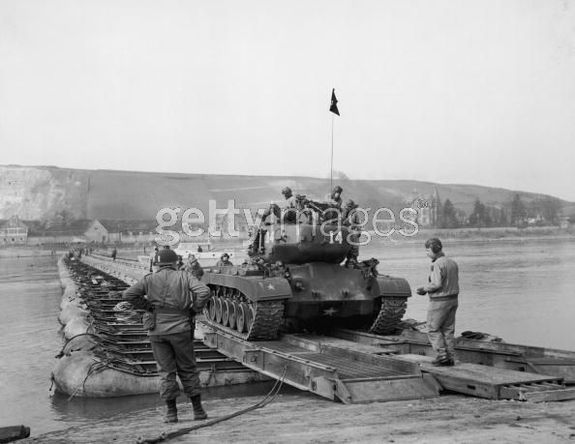
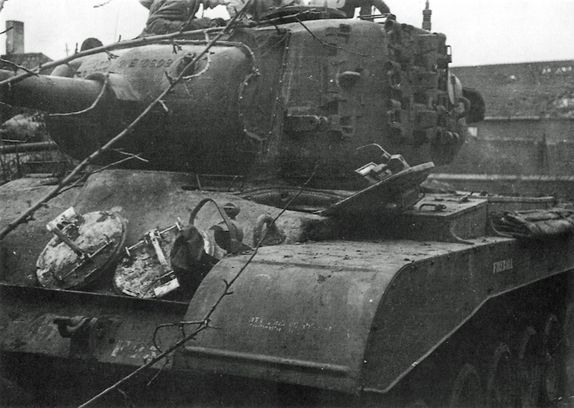


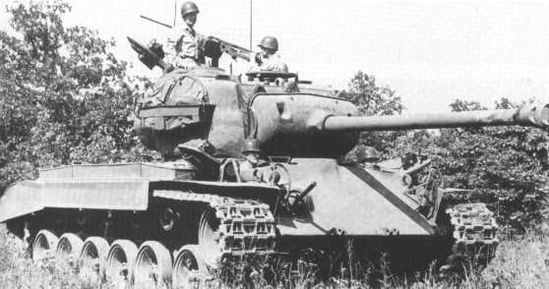





![]()
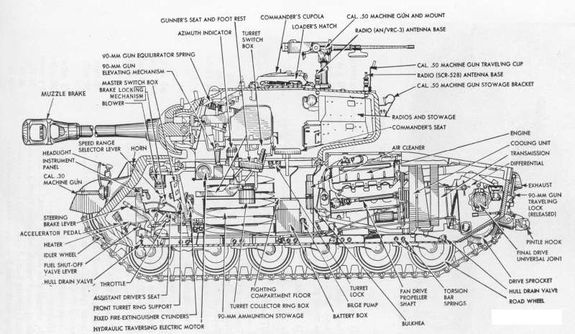

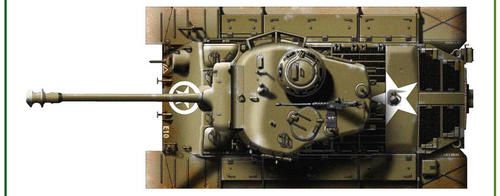

![]()
![]()





















/idata%2F0396584%2FKOREA%2F71910_korea_MIA1_800.JPG)
/idata%2F0396584%2FU.S.ARMY-POST-WW2%2Fphot4901a.jpg)
/idata%2F0396584%2FDRAWINGS-UNIFORMS-WW2%2F30-451-09b-2.jpg)
/idata%2F0396584%2FP-40%2F44FS000.jpg)
/idata%2F0396584%2FGERMAN-U-BOAT%2FBundesarchiv_Bild_101II-MW-1031-28-_Lorient-_U-31.jpg)
/idata%2F0396584%2FSOVIET-ARMY-WW2%2F1.jpg)




